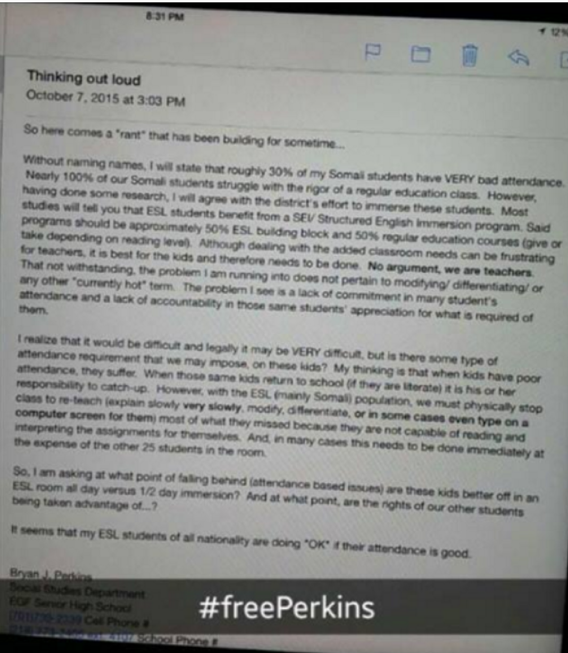Many students and parents in East Grand Forks, Minnesota feel like they are living in the Twilight Zone.
Bryan J. Perkins, a social studies teacher at East Grand Forks High School has been placed on administrative leave after he reportedly questioned the disruptive habits of non-English speaking students at the high school.
 |
| Bryan Perkins |
Students recently protested with signs and chants demanding Perkins be brought be back, which apparently had an affect. According to news reports, Perkins has met with administrators and is scheduled to return to work on October 22.
 |
| Students in East Grand Forks, Minnesota protested the suspension of their teacher, Bryan Perkins, during a recent event. |
Although David Pace, superintendent, EGF High School, is not able to officially comment on Perkins’ suspension, the reason for the suspension is well-known.
On October 7, 2015, Perkins authored an email that addressed the attendance habits of non-English speaking students at the school, and explained how the dismal attendance was ultimately disruptive to the entire learning process of the whole class.
The Perkins email, by any standard, appeared to be an education and student-focused effort by a caring and concerned teacher.
Perkins proposed implementing a requirement that a certain level of attendance must be maintained by non-English speaking students.
“The problem I see is a lack of commitment in many students attendance and a lack of accountability in those same students’ appreciation for what is required of them,” Perkins said.
The Perkins email is transcribed below:
Thinking out loud
October 7, 2015 at 3:03 P.M.
So here comes a ‘rant’ that has been building for sometime…
Without naming names, I will state that roughly 50% of my Somali students have VERY bad attendance. Nearly 100% of our Somali students struggle with the rigor of a regular education class. However, having done some research, I will agree with the district’s effort to immerse these students. Most studies will tell you that ESL students benefit from a SEI/Structured English Immersion program. Said programs should be approximately 50% regular education courses (give or take depending on reading level). Although dealing with the added classroom needs can be frustrating for teachers, it’s best for the kids and therefore needs to be done. No argument, we are teachers. That not withstanding, the problem I am running into does not pertain to modifying/differentiating/ or any other “currently hot” term. The problem I see is a lack of commitment in many students attendance and a lack of accountability in those same students’ appreciation for what is required of them.
I realize that it would be difficult and legally it may be VERY difficult, but is there some type of attendance requirement we may impose, on these kids? My thinking is that when kids have poor attendance, they suffer. When those same kids return to school (if they are literate) it is his or her responsibility to catch up. However, with the ESL (mainly Somali) population, we must physically stop class to re-teach (explain slowly very slowly, modify, differentiate, or in some case even type on a computer screen for them) most of what they missed because they are not capable of reading and interpreting the assignments for themselves. And, in many cases this needs to be done immediately at the expenses of the other 25 students in the room.
So, I am asking at what point of falling behind (attendance based issues) are these kids better off in an ESL room all day versus ½ day immersion? And at one point, are the rights of our students being taken advantage of…?
It seems that my ESL students of all nationality are doing ‘OK’ if their attendance is good.
Bryan J. Perkins
Social Studies Department
EGF Senior High School
 |